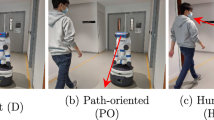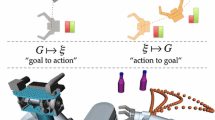Abstract
A general problem in human–robot interaction is how to test the quality of single robot behavior, in order to develop robust and human-acceptable skills. The most typical approach are user tests with subjective measures (questionnaires). We propose a new experimental paradigm that combines subjective measures with an objective behavioral measure, namely viewing times of images viewed as self-paced slide show. We applied this paradigm to human-aware robot navigation. With three experiments, we studied the influence of two aspects of robot motion: velocity profiles and the robot’s orientation. A decreasing velocity profile influenced the predictability of the observed motion, and robot orientations diverting from the robot’s motion vector caused reduced perceived autonomy ratings. We conclude that the viewing time paradigm is a promising tool for studying human-aware robot behavior and that the design of human-aware robot navigation needs to consider both the velocity and the orientation of robots.











Similar content being viewed by others
References
Baguley T (2012) Calculating and graphing within-subject confidence intervals for ANOVA. Behav Res Methods 44:158–175. https://doi.org/10.3758/s13428-011-0123-7
Bartholow BD, Fabiani M, Gratton G, Bettencourt BA (2001) A psychophysiological examination of cognitive processing of and affective responses to social expectancy violations. Psychol Sci 12(3):197–204. https://doi.org/10.1111/1467-9280.00336
Bartneck C, Kulić D, Croft E, Zoghbi S (2009) Measurement instruments for the anthropomorphism, animacy, likeability, perceived intelligence, and perceived safety of robots. Int J Soc Robot 1(1):71–81. https://doi.org/10.1007/s12369-008-0001-3
Bordwell D (1998) Exceptionally exact perceptions: on staging in depth. In: Bordwell D (ed) On the history of film style. Harvard University Press, Cambridge, pp 158–271
Bordwell D, Thompson K (2004) Film art: an introduction. McGraw-Hill, New York
Cohn N, Paczynski M (2013) Prediction, events, and the advantage of agents: the processing of semantic roles in visual narrative. Cogn Psychol 67(3):73–97. https://doi.org/10.1016/j.cogpsych.2013.07.002
Curiel JM, Radvansky GA (2014) Spatial and character situation model updating. J Cogn Psychol 26(2):205–212. https://doi.org/10.1080/20445911.2013.879590
Hard BM, Recchia G, Tversky B (2011) The shape of action. J Exp Psychol Gen 140:586–604. https://doi.org/10.1037/a0024310
Hickethier K (2012) Film und Fernsehanalyse. Metzler, Weimar
Howard CJ, Holcombe AO (2010) Unexpected changes in direction of motion attract attention. Atten Percept Psychophys 72(8):2087–2095. https://doi.org/10.3758/BF03196685
Just MA, Carpenter PA (1980) A theory of reading: from eye fixations to comprehension. Psychol Rev 87(4):329–354. https://doi.org/10.1037/0033-295X.87.4.329
Kim B, Pineau J (2016) Socially adaptive path planning in human environments using inverse reinforcement learning. Int J Soc Robot 8(1):51–66. https://doi.org/10.1007/s12369-015-0310-2
Kirsch A (2016) Heuristic decision-making for human-aware navigation in domestic environments. In: 2nd global conference on artificial intelligence (GCAI)
Kraft RN (1981) The psychological reality of cinematographic principles. Camera angle and cutting. Unpublished dissertation, University of Minnesota, Minneapolis
Kruse T, Pandey AK, Alami R, Kirsch A (2013) Human-aware robot navigation: a survey. Robot Auton Syst 61(12):1726–1743. https://doi.org/10.1016/j.robot.2013.05.007
Lemaignan S, Echeverria G, Karg M, Mainprice J, Kirsch A, Alami R (2012) Human–robot interaction in the MORSE simulator. In: Proceedings of the 2012 human–robot interaction conference (late breaking report)
Lichtenthäler C, Lorenz T, Kirsch A (2012) Influence of legibility on perceived safety in a virtual human–robot path crossing task. In: RO-MAN, 2012 IEEE, pp 676–681. https://doi.org/10.1109/ROMAN.2012.6343829
Lu DV, Smart WD (2013) Towards more efficient navigation for robots and humans. In: IEEE/RSJ international conference on intelligent robots and systems (IROS)
Magliano JP, Kopp K, Higgs K, Rapp DN (2016) Filling in the gaps: memory implications for inferring missing content in graphic narratives. Discourse Process. https://doi.org/10.1080/0163853X.2015.1136870
Magliano JP, Larson AM, Higgs K, Loschky LC (2016) The relative roles of visuospatial and linguistic working memory systems in generating inferences during visual narrative comprehension. Mem Cogn 44:207–219. https://doi.org/10.3758/s13421-015-0558-7
Meyerhoff HS, Papenmeier F, Huff M (2013) Object-based integration of motion information during attentive tracking. Perception 42:119–121. https://doi.org/10.1068/p7273
Meyerhoff HS, Papenmeier F, Jahn G, Huff M (2016) Not FLEXible enough: exploring the temporal dynamics of attentional reallocations with the multiple object tracking paradigm. J Exp Psychol Hum Percept Perform 42(6):776–787. https://doi.org/10.1037/xhp0000187
Papenmeier F, Boss A, Mahlke A-K (2018) Action goal changes caused by agents and patients both induce global updating of event models. J Exp Psychol: Learn Mem Cogn. https://doi.org/10.1037/xlm0000651
Ray RB (1985) A certain tendency of the Hollywood cinema, 1930–1980. Princeton University Press, Princeton
Saerbeck M, Bartneck C (2010) Perception of affect elicited by robot motion. In: Proceedings of the 5th ACM/IEEE international conference on Human–robot interaction, HRI ’10. IEEE Press, Piscataway, pp 53–60. http://dl.acm.org/citation.cfm?id=1734454.1734473
St.Clair R, Huff M, Seiffert AE (2010) Conflicting motion information impairs multiple object tracking. J Vis 10(4:18):1–13. https://doi.org/10.1167/10.4.18
Thompson K (1985) The continuity system. In: Bordwell D, Staiger J, Thompson K (eds) The classical Hollywood cinema. Film style and mode of production to 1960. Routledge, London
Woods S, Walters M, Koay K, Dautenhahn K (2006) Comparing human robot interaction scenarios using live and video based methods: towards a novel methodological approach. In: 9th IEEE international workshop on advanced motion control
Zacks JM, Speer NK, Swallow KM, Braver TS, Reynolds JR (2007) Event perception: a mind-brain perspective. Psychol Bull 133(2):273–293. https://doi.org/10.1037/0033-2909.133.2.273
Zwaan RA, Langston MC, Graesser AC (1995) The construction of situation models in narrative comprehension: an event-indexing model. Psychol Sci 6(5):292–297. https://doi.org/10.1111/j.1467-9280.1995.tb00513.x
Zwaan RA, Magliano JP, Graesser AC (1995) Dimensions of situation model construction in narrative comprehension. J Exp Psychol Learn Mem Cogn 21:386–397. https://doi.org/10.1037/0278-7393.21.2.386
Author information
Authors and Affiliations
Corresponding author
Ethics declarations
Conflict of interest
The authors declare that they have no conflict of interest.
Additional information
Publisher's Note
Springer Nature remains neutral with regard to jurisdictional claims in published maps and institutional affiliations.
We thank Eleni Sianni and Lisa Krösche for their help in conducting the experiments. We provide all data collected in the experiments as open data at the following location: https://osf.io/r4vwk/.
Appendix A: Stimuli for velocity profile “increasing”
Appendix A: Stimuli for velocity profile “increasing”

Rights and permissions
About this article
Cite this article
Papenmeier, F., Uhrig, M. & Kirsch, A. Human Understanding of Robot Motion: The Role of Velocity and Orientation. Int J of Soc Robotics 11, 75–88 (2019). https://doi.org/10.1007/s12369-018-0493-4
Accepted:
Published:
Issue Date:
DOI: https://doi.org/10.1007/s12369-018-0493-4




